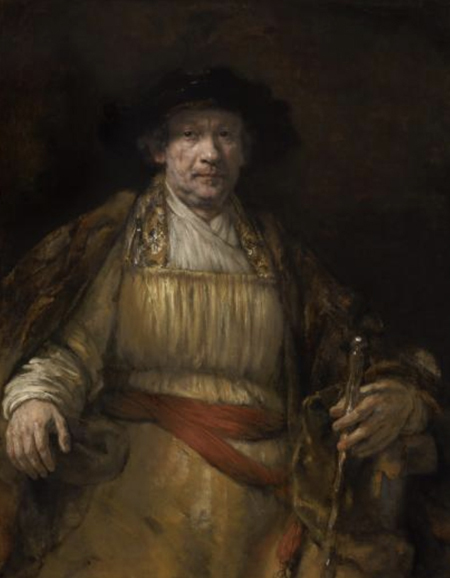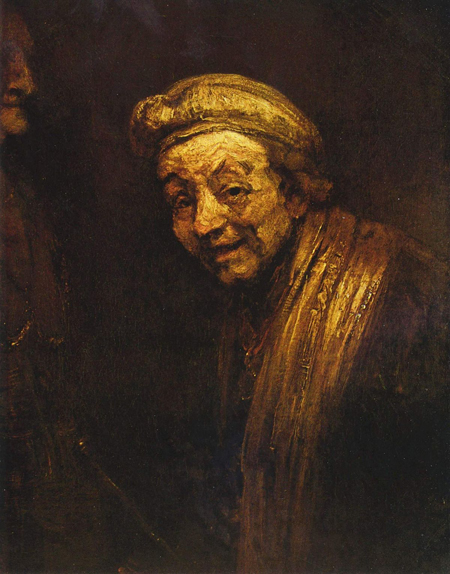Rembrandt and the Shadow
Ron Morosan
July 2020
 Self-Portrait, 1658
Self-Portrait, 1658
In the Frick Museum’s main picture gallery he sits on his wooden throne holding his rattan cane scepter, or mahl stick, staring out at the world and at the future with a determined but resigned look in his eyes. This is the self portrait of Rembrandt van Rijn painted in 1658 when he was fifty-three years old and recently pushed into bankruptcy by creditors and forced to sell his vast art collection and his beloved etching press.
Over the past ten years I have gone to the Frick in the spring especially to look at this portrait. (This year, because of the pandemic, I cannot go.) Every time I visit I find something new in it and something that makes me think more about the kind of artist Rembrandt must have been, and also what he must have been like as a person. Obviously, reams of books have been written about him and many art scholars have interpreted his masterful paintings. In 1658, the same year as this portrait, a German dealer wrote in an inventory: “He was the miracle of our century.” Yet, this self portrait was painted when Rembrandt was at one of the lowest periods in his life. But this portrait shows a painter who is declaring himself the king of painting. The largest of the forty or so painted self portraits it is clearly a painting that is intended to make a major statement.
Rembrandt achieved the highest level of success in his lifetime but also suffered later in life and ended up poor. This is very unusual in the history of art for an artist to achieve great fame and then lose it and fall to the bottom. Circumstances were not good for him in the 1650’s: his wife died a few years before this portrait and he was forced to sell his grand house in the best section of Amsterdam. It is recorded that he had 54 students who he taught to paint very much in his style, but he was known to sign some of those paintings and pass them off as his own. This, too, didn’t help revive his reputation. In 1936 Alexander Korda made the film “Rembrandt” that relates the whole life of the master painter and his fall into poverty. Brilliantly preformed by Charles Laughton, it gives us a sense of an independent spirit and a defiant painter who is determined to go his own way, but who then pays the price.
My fascination with this self portrait began to congeal around the Baroque concept of theatricality. Rembrandt was a brilliant practitioner of dramatic scenes and had the ability to produce light and space in his compositions that caught a genuine sense of the lives of his subjects. His Sacrifice of Issac, 1635, Hermitage Museum, St. Petersburg, Russia is a prime example of the profound moment when the angel halts the knife of Abraham.
In the seascape Christ in the Storm on the Sea of Galilee, 1633, missing from Isabelle Stuart Gardner Museum, Boston, a masterful drama of wind churned spiritual intensity is unfurled across the canvas.
What was it in Rembrandt’s approach that separated him from other Baroque painters and made his work more immediate and intense? What his self portrait reveals to me is that Rembrandt saw himself as an artist in the role of performer. He portrays himself as the King of Painting in the Frick painting, but in a sense he really is that. Though a tattered reputation is a burden to him now, he portrays himself in 16th century costume, like that of a Renaissance Leonardo, or a Raphael. His pleated yellow Jerkin and linen blouse are of that period. His cane is silver tipped and regal. This by no means looks like the portrait of a failed genius.
In looking at his eyes there is a determined look that seems to go over our head to some future, as if he is saying, “The future will judge me and know how great I am.” Though his overall bearing is regal there is also something odd going on with his costume. The yellow shirt is bulging out at the top and bottom giving him a maternal look. It’s almost the look of a pregnant woman. In 1669, the last year of Rembrandt’s life, he would paint three self portraits. In one of them he portrays himself as the Ancient Greek painter Zeuxis.
 Self- portrait as Zeuxis Laughing, 1669
Self- portrait as Zeuxis Laughing, 1669
Its title is Zeuxis Laughing, 1669, Wallraf-Richartz-Museum, Cologne. Yet, this self portrait also looks like Rembrandt sees himself as an old woman bent over and laughing. Are these also Rembrandt the artist performer acting out his life as if it is a drama for history?
Along with the forty or more painted self portraits Rembrandt also produced about the same number of etchings of his face. In them he grimaces and takes various poses in which he is either hamming-it-up or looking serious or grave. In other words he seems to be acting out the poses. This is theatrical in a very private and specific mode.
What I keep seeing in the Frick’s Self-Portrait is an artist who is very aware of himself as an artist of his time and as a performer of that role. His studio was his stage and the society of Amsterdam was his audience. Was Rembrandt one of the first artists to see the art star as a performance artist role?
Rembrandt produced more self portraits in his lifetime than any other artist. In this period of pre enlightenment Europe a pervasive sense of the individual was developing. People were discovering self-awareness. Being born ten years before the death of Shakespeare in 1616, Rembrandt certainly would have know about the great master playwright and probably heard of his play “Hamlet.” Self-awareness was something equated with a dynamism in the individual as well as independence and the capacity to control fate through action. The action was the medium and how one performed it in life would chart the course of that life. Rembrandt as great artist was the drama and the action would be his career, so the self portraits became the documentation of the actor.
In Rembrandt’s later self portraits we see a more introspective artist who seems caught up in contemplating the enormity of existence and fate.
 Self-portrait with Two Circles, 1665-1669
Self-portrait with Two Circles, 1665-1669
Self Portrait with Two Circles, 1665, Kenwood House, London, is almost a mystical composition; the three quarter length portrait of the artist has on the back wall two large perfect circles. In one of the last three paintings painted in his last year of life Self Portrait at Age 63, 1669, National Gallery, London, is filled with intense emotion conveyed in a face that is resigned to suffering in life but is beyond this suffering by redemption through art.
 Self-portrait at age 63, 1669
Self-portrait at age 63, 1669
For me the Frick’s Self Portrait is probably the most introspective self portrait in the history of art. Why? Rembrandt looks at himself and paints his aging self at a point in his life where he ask: Who am I? What makes this portrait so astonishing is its scope of addressing the human condition and seeing it reflected in himself. He visually answer the question of who he is.
Self-Portrait is a portrait of self analysis and assessment on a par with the Meditations of Marcus Aurelius. Like the Meditations it tells us what it is to be a noble human being, how to maintain dignity, how to endure, and how to rise above age, poverty and neglect: how to be a King of Being.
Yet introspection in this painting also raises the viewer to a philosophical plane and invites us to engage in an interactive hermeneutics with the work. Rembrandt’s interpretation of himself is embodied in the process of his painting, in the face, the hands painted in his “rough style,” his costume, and his face, with the shadow almost covering his eyes.
In this portrait Rembrandt is The Painter, as if he is the primal painter, or the Model of the primal painter. The visualization in the painting is an interpretive process itself.
Rembrandt is one of the most studied artists in the history of art. Yet, he is still difficult to interpret, to figure out. Perhaps he is playing the game of interpretation with us, making us think certain things that could or could not be true. This difficult creative concept is made even more complex by paintings that were reattributed to his students after the Dutch Rembrandt Research Project started in 1968 declared many Rembrandts false attributions. Some of these are still being debated. The mystery of Rembrandt has been known for centuries and the statement by Vincent Van Gogh is appropriate:
“ Rembrandt is so deeply mysterious that he says things for which there are no words in any language.”
◊
Ron Morosan is an artist, writer, and curator. He has shown his work internationally at the American Pavilion of The Venice Biennale and the Circulo De Bellas Artes in Madrid, Spain. In the US he has shown at the New Museum and had a one-person exhibition at the New Jersey State Museum, and at numerous galleries in New York. He curated the Robert Dowd exhibition, Subversive Pop, at Center Galleries in Detroit, as well as Denotation, Connotation, Implication at Eisner Gallery, City University of New York. He has written catalogues for many artists, including Enid Sanford, Tom Parish, Robert Dowd, and others. In the 1990’s he started and ran B4A Gallery in Soho, New York, writing press releases, articles, and catalogues.
